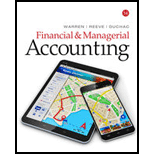
A.
Bonds Payable: Bonds payable are referred to long-term debts of the business, issued to various lenders known as bondholders, generally in multiples of $1,000 per bond, to raise fund for financing the operations.
Premium on bonds payable: It occurs when the bonds are issued at a high price than the face value.
Effective-interest method of amortization: It is an amortization model that apportions the amount of bond discount or premium based on the market interest rate.
Present Value: The value of today’s amount expected to be paid or received in the future at a compound interest rate is called as present value.
To calculate: The amount of cash proceeds (present value) from the sale of the bonds.
B.
To calculate: The amount of premium to be amortized for the first semiannual interest payment period.
C.
To calculate: The amount of premium to be amortized for the second semiannual interest payment period.
D.
The amount of bond interest expense for first year.
Want to see the full answer?
Check out a sample textbook solution
Chapter 11 Solutions
CengageNOWv2, 2 terms Printed Access Card for Warren/Reeve/Duchac’s Financial & Managerial Accounting, 14th
- Nixon Corporation recorded a loss of $7,200 when it sold equipment that originally cost $93,000 for $21,500. Accumulated depreciation on the equipment must have been__. ??arrow_forwardHow much should it be sold for to achieve the desired markup ?arrow_forwardPlease explain the accurate process for solving this financial accounting question with proper principles.arrow_forward
- Calculate the cost of goods soldarrow_forwardAllstate Enterprises has a discontinued operation gain of $60,000 and a 30% tax rate. What is the effect on net income? a. Increase of $42,000 b. Increase of $60,000 c. Increase of $18,000 d. No effect need helparrow_forwardCan you solve this general accounting question with the appropriate accounting analysis techniques?arrow_forward
- Provide correct solution and accounting questionarrow_forwardWhich principle dictates that a business should report revenue when it is earned and expenses when they are incurred? a) Accrual Principle b) Matching Principle c) Revenue Recognition Principle d) Cost Principle MCQarrow_forwardPlease provide the answer to this general accounting question with proper steps.arrow_forward

 AccountingAccountingISBN:9781337272094Author:WARREN, Carl S., Reeve, James M., Duchac, Jonathan E.Publisher:Cengage Learning,
AccountingAccountingISBN:9781337272094Author:WARREN, Carl S., Reeve, James M., Duchac, Jonathan E.Publisher:Cengage Learning, Accounting Information SystemsAccountingISBN:9781337619202Author:Hall, James A.Publisher:Cengage Learning,
Accounting Information SystemsAccountingISBN:9781337619202Author:Hall, James A.Publisher:Cengage Learning, Horngren's Cost Accounting: A Managerial Emphasis...AccountingISBN:9780134475585Author:Srikant M. Datar, Madhav V. RajanPublisher:PEARSON
Horngren's Cost Accounting: A Managerial Emphasis...AccountingISBN:9780134475585Author:Srikant M. Datar, Madhav V. RajanPublisher:PEARSON Intermediate AccountingAccountingISBN:9781259722660Author:J. David Spiceland, Mark W. Nelson, Wayne M ThomasPublisher:McGraw-Hill Education
Intermediate AccountingAccountingISBN:9781259722660Author:J. David Spiceland, Mark W. Nelson, Wayne M ThomasPublisher:McGraw-Hill Education Financial and Managerial AccountingAccountingISBN:9781259726705Author:John J Wild, Ken W. Shaw, Barbara Chiappetta Fundamental Accounting PrinciplesPublisher:McGraw-Hill Education
Financial and Managerial AccountingAccountingISBN:9781259726705Author:John J Wild, Ken W. Shaw, Barbara Chiappetta Fundamental Accounting PrinciplesPublisher:McGraw-Hill Education





